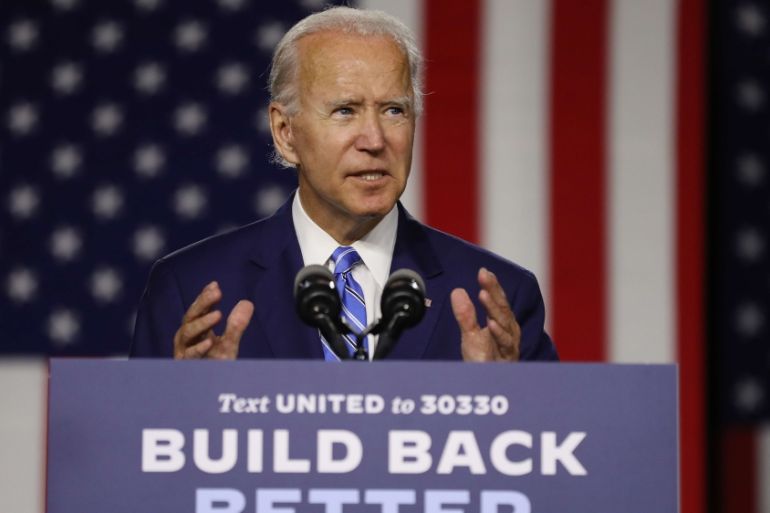Biden can create a ‘new’ New Deal
But he will need a coalition of progressives and centrists to unite around it.

Hunkering down in his Delaware basement has not protected Joe Biden from political attacks.
That he is receiving jabs from those on the political right is expected, especially as polls show the presumptive Democratic Party nominee’s lead over President Donald Trump increasing almost daily.
Keep reading
list of 4 itemsUS senators call on Biden to sanction Sudan’s RSF over human rights abuses
‘Unconscionable’: US sends dozens to Haiti on deportation flight
US imposes new sanctions on Iran after attack on Israel
What is more of a worry for Biden’s electoral ambitions are the critiques coming at him from the left of the political spectrum.
In this regard, the question is if Biden can thread the political needle – that is, unite progressives and centrists on the American left to beat Trump in November.
Where we are seeing some life from the Biden campaign precisely on this point is in his latest economic proposal – his $700bn economic recovery plan. While not exactly “red meat” for leftists, the plan contains critical elements that have the potential to serve as the basis for putting together a broad coalition.
If Biden plays his cards right and builds from his plan, then he could help lead the charge behind the creation of a “new” New Deal, or in other words, a series of policies with a coalition behind them that would address critical problems in environmental policy, race relations and infrastructure.
Read Biden’s plan in detail, and one cannot help but see shades of other radical plans from the left.
For instance, even though Biden’s proposal is not as ambitious as the Green New Deal, his plan does pay significant attention to addressing climate change by promising net-zero emissions by 2050, as well as pledging to reform trucking, shipping, and aviation technologies to reduce their collective carbon footprint.
On racial justice, Biden has said that he does not support calls to defund the police. Still, his billion-dollar economic recovery plan addresses various issues of concern to communities of colour.
More specifically, Biden’s plan features a section on ensuring clean drinking water – calling attention to Flint, Michigan. In this city, people of colour suffered disproportionately from lead poisoning after state and city officials decided to switch the city’s water source from Lake Huron to the Flint River in 2014.
Additionally, Biden’s proposal features a section on including historically marginalised communities in decisions pertaining to transportation planning. Not only is he making a point to involve people of colour in the decision-making processes concerning future projects, such as the construction of highways and airports, but he also proposes the creation of a Community Restoration Fund that would distribute resources to people in areas who have been negatively impacted by past investments.
Biden’s vision for infrastructure includes making substantial repairs to roads and highways, investing billions in education, and ensuring that everyone in the country has access to high-speed internet.
The focus on infrastructure is not simply about making things. The idea, at least according to the plan, is to have people doing this work in union jobs, earning pay that would put them into, at least, the middle class.
When considering the impetus for this plan, we must recall that Biden is making these proposals due to the overlapping health and economic crises that the coronavirus pandemic has forced upon us.
That, as well as the brutal murder of George Floyd, at the hands of Minneapolis police, which has triggered protests around the world against white supremacy.
If there has been a historical moment somewhat analogous to what we are witnessing now, then that would be when the Great Depression brought the world to its knees in the 1930s.
At that time, the global economic crisis shot unemployment to close to 25 percent in the United States. Franklin Delano Roosevelt, when he was elected president in 1933, initiated a series of programmes to address a country in economic freefall. His administration proceeded to enact a variety of substantial measures, including the creation of social security, the legalisation of collective bargaining for private-sector unions, as well as a series of government-funded infrastructure projects that put unemployed people to work.
Those policies did not emerge from presidential fiat – they were forged with a coalition of actors, including labour and farm movements, as well as people of colour in urban areas in the northern US and Democrats in the South.
The New Deal had serious faults – principal among them excluding rural workers from unionising. The reason at the time was to ensure the support of Southern landowners, many of whom employed African American and poor white sharecroppers on their large-scale operations.
We should assess Biden’s multibillion-dollar plan in the context of the New Deal. Seemingly, his proposal carries within it enough different proposals to build a coalition the likes of which we have not seen since many different groups of people came together in the 1930s.
More than that, perhaps, we may see this rising coalition – with Biden ostensibly reaching out to people demanding environmental, racial and economic justice – address the shortfalls that the first New Dealers failed to.
Biden may neither be the perfect messenger, nor the ideal candidate. Regardless, we need to remember that the presidency is not one person, but an administration of thousands. This means that influence has potentially many ways to reach the top. This also means that now there is reason for optimism on the left – as nationwide protests have caught the candidate’s attention, perhaps Biden’s campaign will continue to hear the call for change and see it through.
The views expressed in this article are the author’s own and do not necessarily reflect Al Jazeera’s editorial stance.
